Table of Contents
The Desert Rose Bonsai is a houseplant commonly grown in temperate regions. The tree is native to Africa as well as the Arabs: popular among growers for its shiny bright, and beautiful display of flowers during springtime.
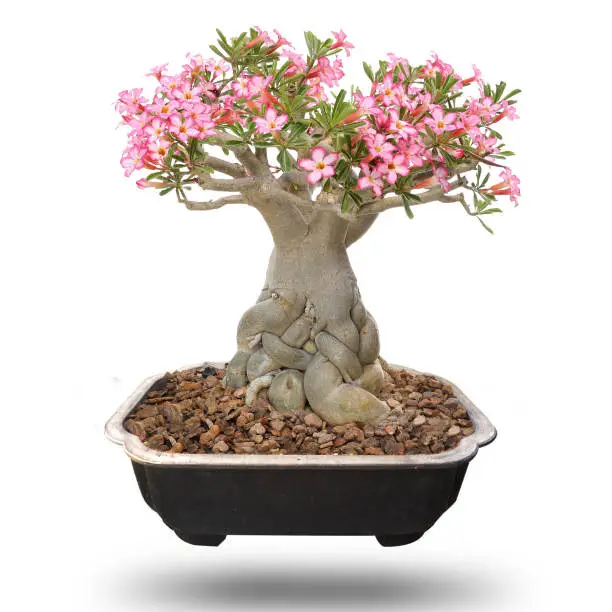
Although most growers around tropical areas believe a Desert Rose Bonsai is best grown in gardens, they can make a perfect ornament for your interior decorations.
Growing a Desert Rose is pretty easy as they respond well to proper treatment. Read this article to learn all you need to know about this lovely tree, as well as every care requirement needed for their smooth cultivation.
| Scientific name | Adenium Obesum |
| Average height | 3 to 9 feet |
| Average spread | 3 to 5 feet |
| Origin country | Tropical Africa, Arabian Peninsula |
| Family | Apocynaceae |
| Leaf | Evergreen |
| Flower Color | Red, rose or pink |
| Attracts | Hummingbirds, Butterflies |
| Water | Dry |
| Sunlight | Full sun |
| Maintenance | Low |
Desert Rose History
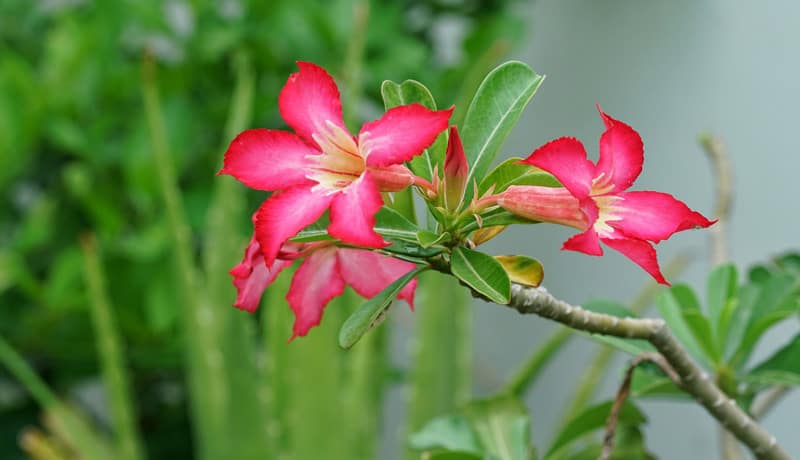
The history of the Dessert Rose can be traced back to many origins with tropical climates like Africa, America, Asia, and Australia. There are various varieties of the tree species from which most of the hybrids we have today were birth. Robert Brown a renowned Scottish Botanist pronounced Sturtia gossypioides as the name for the Australian version of the tree in 1849.
From time to time, the Dessert Rose has been called other various names in history like; Australian cotton, Darling river rose, and the Cotton rosebush. The Dessert Rose, popularly called Adenium obesum which is originally from Africa and Arabia has also gone through name-changing phases in history.
However, over the years, the Franciscan Desert Rose has remained unchanged; but interestingly, it is not a popular name in horticulture but rather a household name in the realm of high-quality dinnerware.
Is dessert rose a Bonsai?
Yes, you can use a Dessert Rose tree for Bonsai. The Desert Bonsai has many special features that make it one of the top choices for Bonsai specimens. Asides from the fact that the tree is characterized by showy flowers, it is a natural house plant that can add to the beauty of any landscape.
However, the tree is a slow-growing plant, so you may have to be a little patient before you start to see results for your effort.
Desert Rose Bonsai scientific name
The scientific name of a Dessert Rose is Adenium obesum.
Desert Rose Bonsai care
Yes, Desert Rose may be an attractive plant, but if it is malnutrition or treated improperly, your tree is bound to exhibit unhealthy growth, and if such a habit continues without proper recommendation or advice, you may lose your tree. Check below for details on how you can treat your Dessert Rose Bonsai in the best possible way.
Desert Rose Bonsai Temperature
Desert Rose is a desert plant, which means they favor heat more than cold, therefore, they should not be exposed to any temperature level lower than 40°.
During spring and summer when the temperature is usually high, you should take your tree outdoors to enjoy the full sun of the day: however, during winter, letting your tree stay outdoors for a long time will put its health at risk, so you should bring it in once you noticed the temperature has dropped below the standard level.
Desert Rose Bonsai Fertilizer
A Dessert Rose prefers a fertilizer rich in Phosphorous to a Nitrogen-rich fertilizer. Therefore, to stimulate healthy growth and improve the flowering of your tree, feed it with fertilizer that is rich in phosphorous at least once a month. This should be done in its active seasons (spring and summer), and also you must water your plant after fertilizer application.
Desert Rose Bonsai fertilizer ratio
A Desert Rose tree prefers its fertilizers to be applied steadily in low dosages rather than being supplied in high dosages but infrequently. As a result, water-soluble fertilizers should be applied in slow-release in the ratio of 13-13-13 every month.
Desert Rose Bonsai Pruning & Trimming
Like most other trees used for Bonsai, the Desert Rose Bonsai also require some regular pruning so it doesn’t grow beyond normal standard. A Desert Bonsai is best pruned before it starts to bloom. Another added advantage to Desert Bonsai pruning is that they can be pruned regularly throughout the year.
Like in all trees, pruning encourages new growths on Desert rose branches, which will create opportunities for the formation of new flower buds, since new buds sprouts from new growth.
How to trim a Desert Rose Bonsai
The processes involved in trimming a Desert Rose are not complicated, however, you must adhere to the precautions that will be provided shortly after the process. Check below for details on how to go about it.
- Cut back every long shoot.
- Completely remove all damaged me infect branches growing in the wrong direction.
- Give your tree some time to heal.
Warning!!!
When cutting, make a clean cut right on the leaf node, and also, make sure you are putting on a glove when pruning a Desert rose because their sap is considered poisonous.
Desert Rose Bonsai repotting
You should repot your Desert Rose Bonsai at least once every 2 to 3 years. This should be done during spring and must be done together with root-pruning. When repotting, make sure to make use of a well-draining soil mix to prevent waterlogging when watering the plant. Also, the new pot must be at least 2/3 as vast as the present height of the tree.
Desert Rose Bonsai Pests & Diseases
Although Desert Rose Bonsai can be affected by other pests like aphids, spider mites, mealybugs, and some other insects common to another Bonsai tree too: however, the biggest threat to a Desert Bonsai tree is root rot. Root rot can be corrected by switching the soil of the tree to a well-draining coarse Bonsai soil. You should see to it that your Desert Bonsai tree is not soaked at any time.
To remedy the threats posed by other pests (mentioned earlier), apply neem oil insecticides on affected trees as soon as you discover their presence on your tree.
Treat Oleander Caterpillar infestation by picking them with your hand on spotting them, then spray the tree with Bacillus thuringiensis.
Desert Rose Bonsai soil
The most interesting thing about the Desert Rose Bonsai is they don’t care what soil you plant them with; all that matters to them is planting them in a soil mixture that encourages soil-draining so that they don’t get soggy.
Desert Rose Bonsai Watering
The “Desert” in Desert Rose Bonsai is not there as a dummy, it is there as an indication that the tree will survive in places with little or no water as they do not fancy too much water. Therefore, you should only water a Desert Bonsai tree once a week or 10 days.
During winter, your Desert Rose Bonsai may benefit from putting them in a shallow tray filled with fine gravel and water. The will keep the plant humidified throughout the season while also preventing it from getting soggy at the same time.
Desert Rose Bonsai sunlight requirement
You should expose your Desert Rose Bonsai to direct sunlight because it is one of the best treatments you can give them. Desert Rose Bonsai do pretty well when raised under a temperature level between 70°f to 100°f.
As said earlier, you should not allow the prevailing temperature level under which your Bonsai is growing to drop below 40°F. Any temperature below that level will negatively affect your tree.
Desert Rose Bonsai types
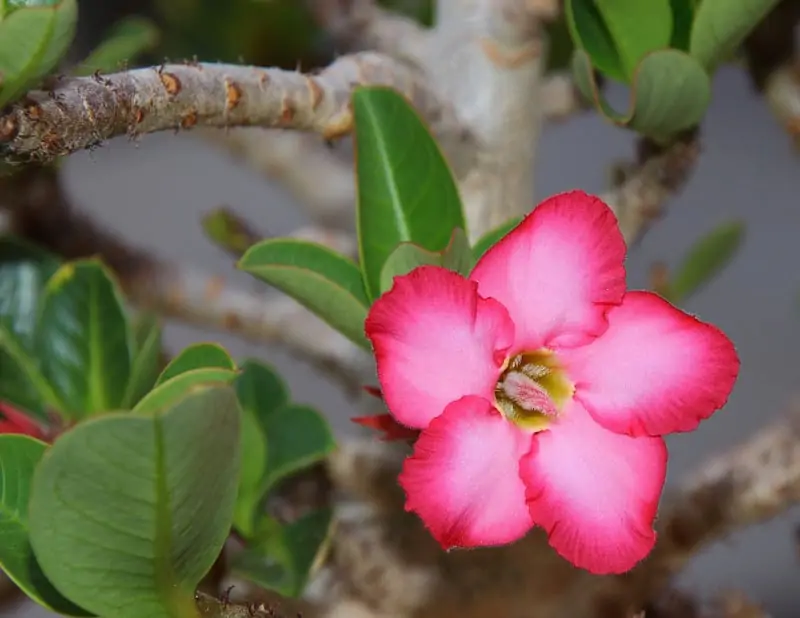
Over the years Growers have been able to work with several hybrids of Desert Rose Bonsai trees. These hybrids have been created to have different flower colors and beautiful Caudex. However, there is only one type of Desert Rose Bonsai which is the Adenium Desert Rose Bonsai.
Other Desert Rose Bonsai hybrids include; Desert Rose Red pivoted, Desert Rose Yellow Fragrance, Desert Rose Black fire, Desert Rose, Harry Potter, Desert Rose Black widow e.t.c. Check below for details about the Adenium Desert Rose Bonsai.
Adenium Desert Rose Bonsai
The Adenium Desert Rose Bonsai is an evergreen deciduous plant native to Africa and Arabia. They are popular among growers for their fleshy leaves, succulent trunk, and their colorful flowers. When grown in tropical and warm climates, they are usually planted outdoors, but when cultivated in cooler areas, they are usually planted indoors.
The best time to plant Adenium Desert Bonsai is spring: however, you must be extra careful during winter because if they are exposed to freezing temperatures, they will die.
Modern Sprout Desert Rose Bonsai
The Modern sprout Desert Rose Bonsai comes with everything you need to start growing: all you need to do is to add water and a place where it will get enough sunlight. Items you will find in a Modern Desert Rose Bonsai include;
- Coco pith disk
- Stainless steel Net pot
- Polypro wick
- Instruction manual
- Plant food
- Activated carbon
- Non-GMO Desert Bonsai seed
Desert Rose Bonsai growth rate
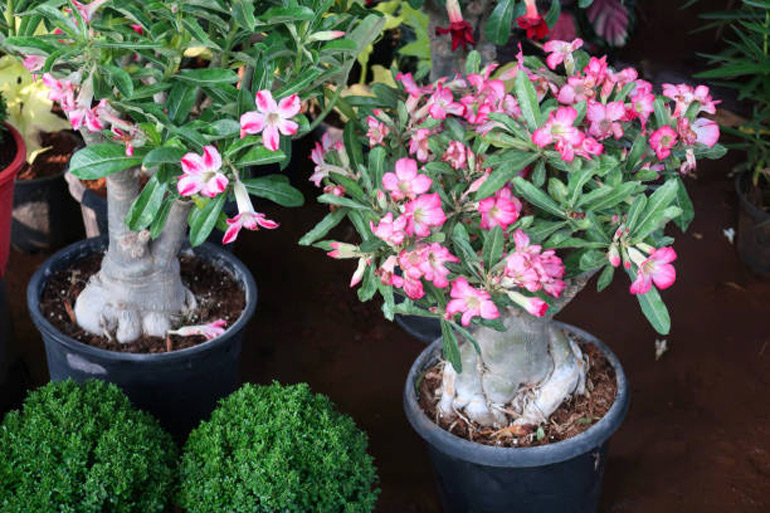
Desert Rose is a slow-growth plant as they can only add 12 inches to their height per year.
Can I Bonsai Desert Rose indoor?
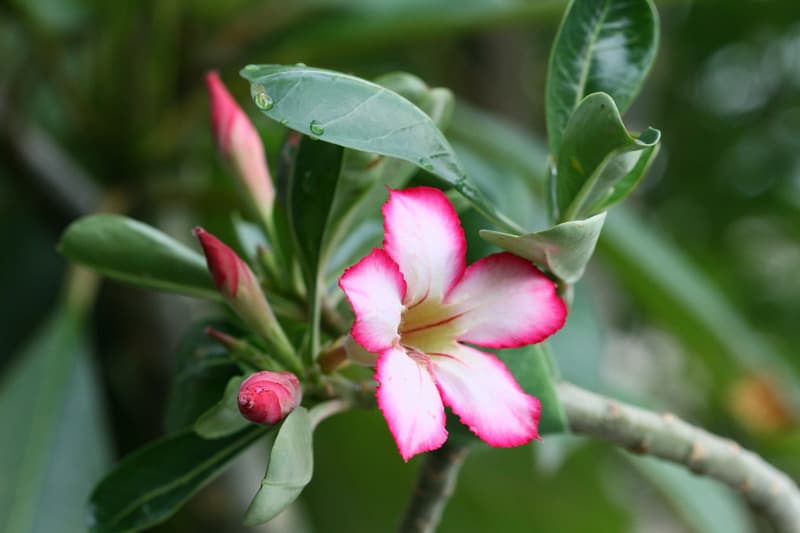
Yes, you can Bonsai a Desert Rose indoors. However, the Desert Rose plant prefers warmer to cooler temperatures, therefore, if you want to raise your tree indoors, place it in a place where it can receive direct sunlight.
Raising a Desert Bonsai under insufficient sunlight is risky: if you prefer to raise it indoors and in the only available space for you to place the tree, it will not have enough sunlight, you should take it out to enjoy the full sun of the day and take it back inside once the outdoor temperature drops.
How to Bonsai a Desert Rose plant
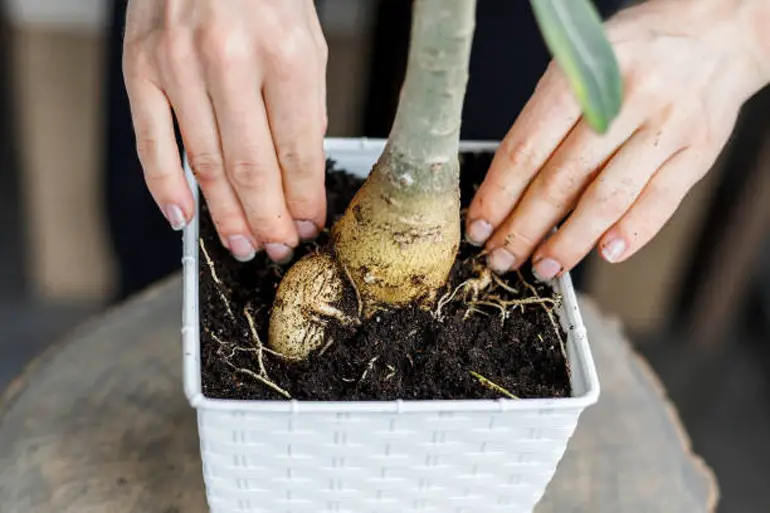
You can Bonsai a Desert Rose plant using either the tree’s cuttings or seed. Growing a Desert Rose is easy, check below for information for how best to propagate the tree with cuttings and seed.
Growing Desert Rose from seed
If you are new to the Bonsai world and you would like to start with a Desert Bonsai, it is better that you start with the cuttings because growing a Desert Rose Bonsai using seed can be a little challenging. But if you would like to go ahead regardless, start with fresh seeds because they have a high germination rate. After you’ve got your seed, proceed with the following steps.
- Put the seed in a Bonsai pot or container with a well-draining soil mix. You can make a mixture of sand and bonsai perlite.
- Cover the seed with a thin layer of the soil mix.
- Water the seed afterward and once in 3 days thereafter until seedlings emerge.
- The seedlings should be kept on a heating pad to keep the temperature level at 80 degrees or higher.
The seed should start to germinate within 1 week from that period.
How to grow Desert Bonsai using cuttings
The process involved in starting a Desert Rose Bonsai with cuttings is less complicated, check below for details on how to go about it.
- Make cuttings from the tip of a Desert Rose tree.
- Leave the cuttings to dry out for some days.
- Moisten the cuttings then put in a rooting hormone.
- Dip the cuttings into a growing medium and water every day.
Root should start to form within 2 weeks.
Why is my Desert Rose Bonsai not blooming
Desert Rose Bonsai needs enough sunlight to grow, and when they are not exposed to enough sunlight, they may not bloom as they are supposed to. This can be corrected by putting your plant under direct sunlight for at least 6 hours or more per day.
How to make my Desert Rose Bonsai Blooming
Desert Rose Bonsai should start blooming after 7 to 8 months from sowing. If your plant refuses to bloom within this period, it may be because they are not receiving enough sunlight. Your best bet at remedying this is exposing your plant to enough sunlight per day. At least 6 hours to be precise. Also, make sure you fertilize your plant once a month. This should be done during spring and summer.
Why are the leaves of my Desert Rose Bonsai turning yellow and falling off?
If the leaves of your Desert Rose are turning yellow, it may be as a result of the following 7 reasons.
- Overwatering
- Underwatering
- Wrong soil
- Lack of adequate sunlight
- Fungus
- Pest infestation
- Lack of sufficient nutrients
Is Desert Rose Bonsai toxic to humans?
Yes, the Desert Rose Bonsai is toxic to humans as well as pets and horses. The sap of the tree contains potent toxins that if ingested in large quantities, can lethally affect humans and some animals. It is said that the more of the toxin ingested, the lesser the chances for survival.
Is Eposom salt good for Desert Rose?
Yes, Eposom salt is a good organic supplement for a Desert Rose Bonsai. However, you must know the best application practice for effective use.
Eposom salt application
- Make a solution from the mixtures of half cup of Eposom and water.
- Water the soil with the solution.
Warning!!!
You should be careful not to apply the solution on the leaves because it can lead to leaf scorch.
![Pittosporum Bonsai [Pittosporum Tobira]](https://www.bonsai-express.com/wp-content/uploads/2022/05/Pittosporum-Bonsai-365x200.jpg)
![Sorbus Bonsai [Sorbus Aucuparia]](https://www.bonsai-express.com/wp-content/uploads/2022/05/Sorbus-Bonsai-365x200.jpg)
![Tsuga Bonsai [Tsuga Canadensis]](https://www.bonsai-express.com/wp-content/uploads/2022/05/Tsuga-Bonsai-365x200.jpg)
![Tamarix Bonsai [Tamarix Ramosissima]](https://www.bonsai-express.com/wp-content/uploads/2022/05/Tamarix-Bonsai-365x200.jpg)